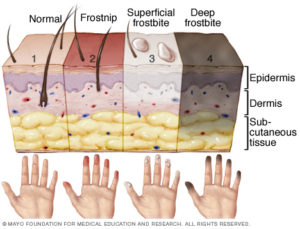Frostbite is common during extremely cold weather. Symptoms and treatment vary by the severity of the case.
What is it?
Frostbite is freezing of the skin and underlying tissue. The most common cause of frostbite is exposure to extremely cold and windy weather.
Prevent frostbite by keeping skin covered and warm while in extreme outdoor conditions. Fingers, toes and ears are the most likely tissue to be damaged by frostbite.
How can I tell if I have it?:
- Red, pale or bluish-grayish skin discoloration
- Pain, burning, tingling, numbness, clear blisters, mottled skin and blood blisters
- Firm skin with soft underlying tissue that moves but feels hard and solid
How is frostbite treated?
First Aid depends on the severity of the injury.
- Frostnip, is the mildest form of frostbite, and can be treated by the patient. It only affects the top layer of tissue and has no lasting effects. The frostbitten area can be treated by rewarming the area by soaking in warm water for 15 – 30 minutes. Avoid direct heat, like a heater or fireplace, because it can cause burns. Treat with an over-the-counter pain reliever, like ibuprofen, if swelling and pain are an issue.
- If any of these symptoms develop seek medical attention – lasting or persistent pain, burning sensations, tingling, numbness, blood blisters, swelling and very pronounced discoloration of the skin. Blisters and skin discoloration may develop hours to days after exposure. If blisters are present do not break them because the unbroken skin helps keep the affected area clean and free of bacteria that can cause an infection in addition to the frostbite. Diagnostic tests may be needed to assess the severity of the injury.
Follow this link for a more in depth discussion about frostbite from the Mayo Clinic.




